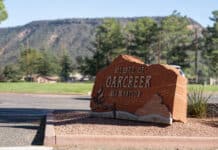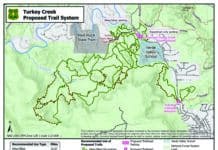After our massive snowstorms this winter and several days of flooding this spring that were on par with the floods of 2004, we’re thankful to breathe a sigh of relief at the end of the fury Mother Nature can bring to us here in northern Arizona.
While our latest snowstorms were certainly big, newcomers to Sedona may assume they broke records, but Sedona has recorded bigger snow storms as recently as 2018 and more overall snowfall in other years. It is atypical for us to have a major snowfall, then days of warm temperatures, then another traffic-snarling dump of snow that shuts down the city.
The recent flooding this week was also severe, although the floods of December 2004 were higher, forcing officials to briefly shut down traffic on the old State Route 179 bridge near Tlaquepaque — the new bridge was built about 12 years ago — and washing a few mobile homes into the creek.

Photo courtesy of Christopher Lane
Now, after the snowy winter and the wet spring, we only have to cope with the man-made disaster that is tourist season, as the rolling spring break that should end sometime in April rolls over us.
The recent snowmelt and heavy rains have only helped to bring Yavapai County officially out of drought, according to the federal U.S. Drought Monitor. Our climate is now designated as “extremely dry.”
All this continued moisture means that the greenbelts between our communities and the foliage around our homes will blossom and bloom massively in the weeks and months to come. That will be great for hikers and photographers, but not so great for those with allergies. An even greater risk is the increase in fire fuels.
Once tourist season ends and children and young adults nationwide graduate from schools and colleges in May, we will be entering fire season. Our moistened landscapes may make fires less severe here in the desert, but the increased amount of foliage may also make fires more common and more likely to spread.
There’s not much we can do to stop fires on forest lands caused by lightning or the occasional downed cross-county power line after a windstorm, other than battle them when they threaten homes and communities. However, we can take action now to clear defensible spaces around our homes on our properties and deny potential fires the ability to jump from one side of the road to the other or from one property to another should a fire break out near us.
The U.S. Forest Service has consolidated dispersed camping west of Sedona and east of Cottonwood into just a handful of sites, so fires are less likely to be started by tourists or local campers who don’t put out their campfires properly.
fseprd1021732Remember that if you go camping and put out your campfire, the fire is too hot to leave if the ashes are still hot to the touch. Stay put, pour on more water or sand and wait until you can safely touch the remnants bare-handed.
That said, wildfires rarely start at safe, legal and regularly-used campsites that have yards of cleared space around them, free of brush and flammable debris. Rather, they often begin at surreptitious campsites built illegally where they should not be, or intentionally hidden from sight off the beaten path. These sites haven’t been cleared by USFS officials, campsite managers or other previous recreationists and are sometimes abandoned in a hurry.
This was what likely caused the 4,317-acre Brins Fire in 2006 on Brins Mesa — the denuded treeline atop Wilson Mountain can still be seen from Uptown.

Andrew Hreha/Special to Larson Newspapers
Most wildfires are human-caused, so we should all take caution, properly extinguish campfires and barbecues, avoid using anything that produces free-flying sparks, refrain from smoking cigarettes or marijuana on open forest lands and keep an eye out for tourists who may not know the rules. Be kind but firm when explaining to tourists why they should not flick cigarette butts away or abandon fires that are still smouldering.
If you want more guidance on creating defensible space around your home, contact your local fire agency and ask a firefighter or the fire marshal to walk your property with you.
We’re going to have one of the greenest springs and summers in recent memory thanks to all this rain. Let’s keep it green.
Christopher Fox Graham
Managing Editor



















